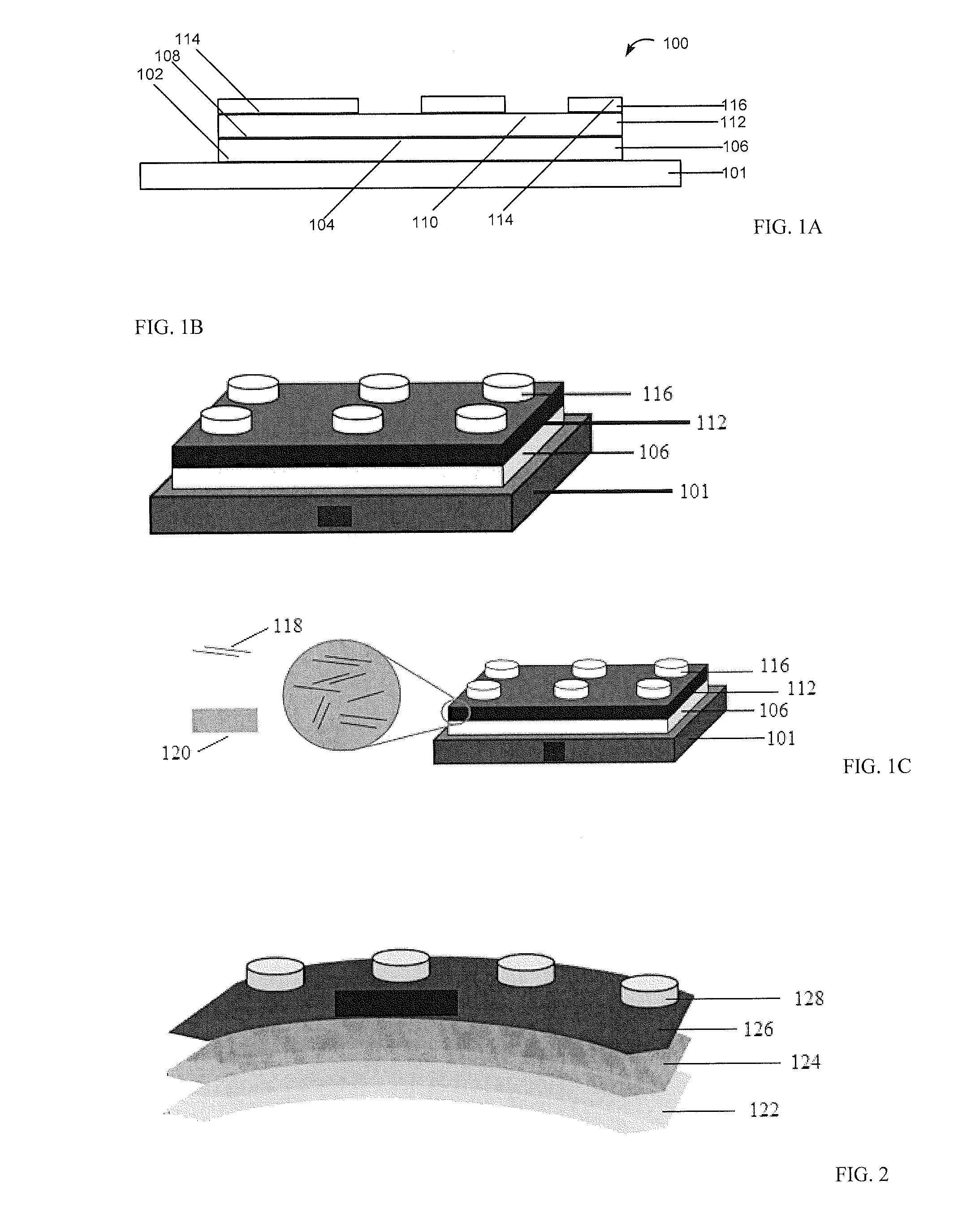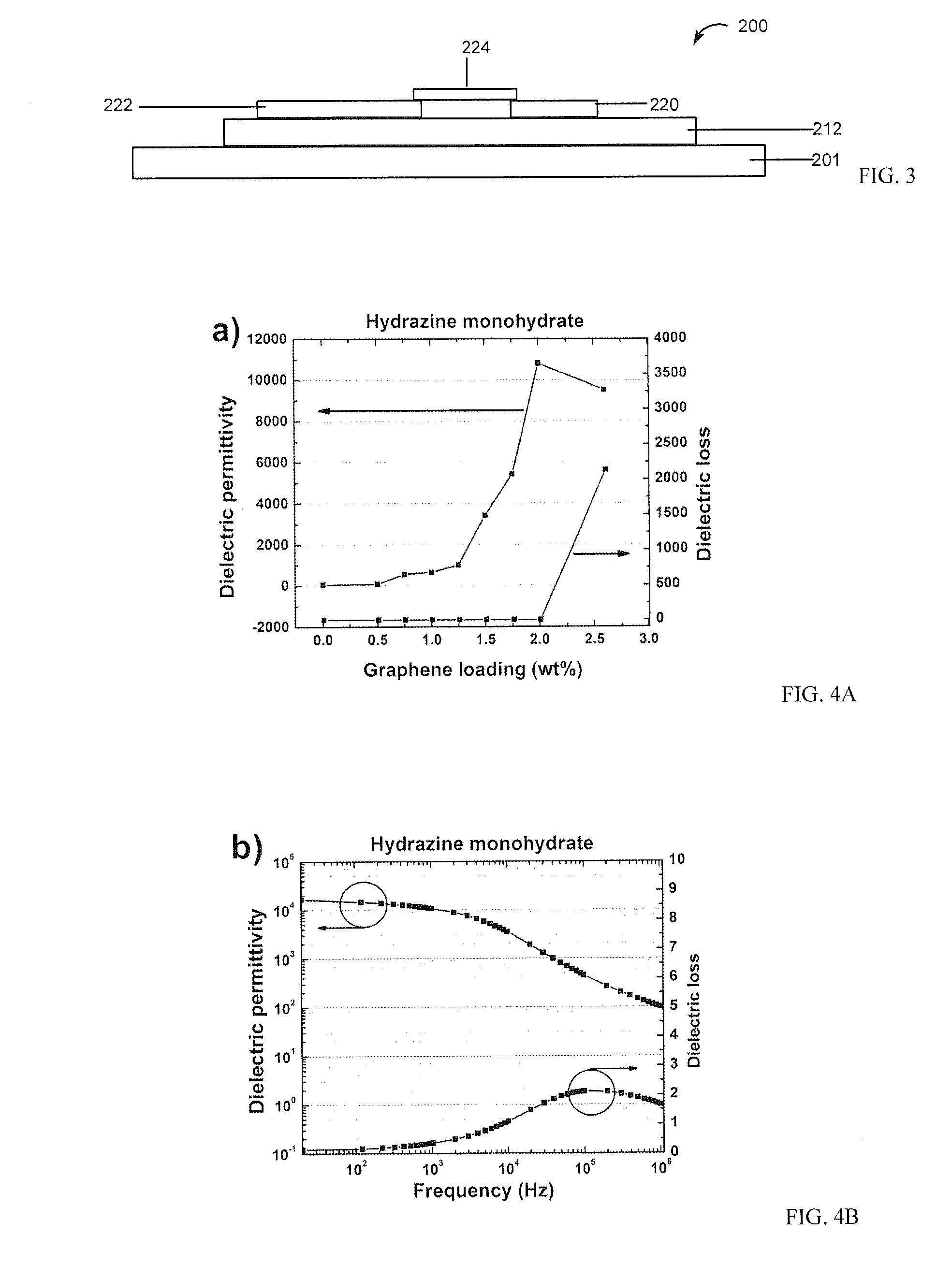Graphene-based composite materials, method of manufacture and applications thereof
- Summary
- Abstract
- Description
- Claims
- Application Information
AI Technical Summary
Benefits of technology
Problems solved by technology
Method used
Image
Examples
example 1
[0069]A hydrazine monohydrate reduced graphene oxide / P(VDF-TrFE-CFE) composite material was prepared as follows.
[0070]Graphene oxide was prepared from natural graphite according to a modified Hummer's method as described by Park. S. et al. in Chemical Materials, volume 20, pp. 6592-4 (2008). For example, 75 ml of concentrated sulfuric acid was added to 1.5 g of graphite powder and 1.5 g of sodium nitrate in the beaker and stirred for 15 min at room temperature before the beaker was kept in an ice bath. Then 9 g of potassium permanganate was added slowly into the mixture and kept in the ice bath for 30 min. After the ice bath was removed, the reaction was continued for 48 hours under stirring at room temperature. The brown slurry or thick paste was then added into 138 ml of deionized (DI) water and the brown suspension was stirred for 10 min Next, 420 ml of warm water was added followed by a slow addition of 30 ml of hydrogen peroxide to provide a yellow suspension. The suspension wa...
example 2
[0074]With reference to FIGS. 1A, 1B, and 1C, a capacitor device 100 was fabricated on a platinum coated silicon substrate 101 having a dielectric thin film 112 between the platinum 106 and aluminum electrode 116.
[0075]Platinum coated silicon substrates were cleaned with acetone, isopropanol and deionized water. HZ-rGO / P(VDF-TrFE-CFE) composite material in DMF was drop-cast directly onto platinum. The cast film was left to dry overnight in air. Air-dried films were transferred into a vacuum oven and dried at 70° C. for 48 h. Top aluminum electrodes were thermally evaporated and patterned on the top surface of the films using a shadow-mask
example 3
[0076]Capacitors can be fabricated using different substrates and / or electrodes. All-organic capacitor devices can be fabricated on high performance polyetherimide substrates such as SABIC ULTEM® 1000B. Given the low temperature processing of the composite materials of this disclosure, fabrication can also be extended to other substrates such as PET and LEXAN®. These flexible substrates are coated with a thin layer of highly conducting polymer(poly(3,4-ethylenedioxythiophene):poly(styrene sulfonic acid), PEDOT:PSS Clevios PH-1000 (Heraeus) doped with ˜4% Dimethylsulfoxide (DMSO)), serving as a bottom electrode. Top electrodes are patterned via inkjet printing of doped PH1000. FIG. 3 illustrates a capacitor device fabricated on a flexible substrate having a thin film dielectric between two highly conducting doped PEDOT:PSS electrodes, wherein the dielectric thin film comprises the composite materials of this disclosure, for example HZ-rGO / P(VDF-TrFE-CFE).
PUM
| Property | Measurement | Unit |
|---|---|---|
| Thickness | aaaaa | aaaaa |
| Thickness | aaaaa | aaaaa |
| Dielectric polarization enthalpy | aaaaa | aaaaa |
Abstract
Description
Claims
Application Information
 Login to View More
Login to View More - R&D
- Intellectual Property
- Life Sciences
- Materials
- Tech Scout
- Unparalleled Data Quality
- Higher Quality Content
- 60% Fewer Hallucinations
Browse by: Latest US Patents, China's latest patents, Technical Efficacy Thesaurus, Application Domain, Technology Topic, Popular Technical Reports.
© 2025 PatSnap. All rights reserved.Legal|Privacy policy|Modern Slavery Act Transparency Statement|Sitemap|About US| Contact US: help@patsnap.com



